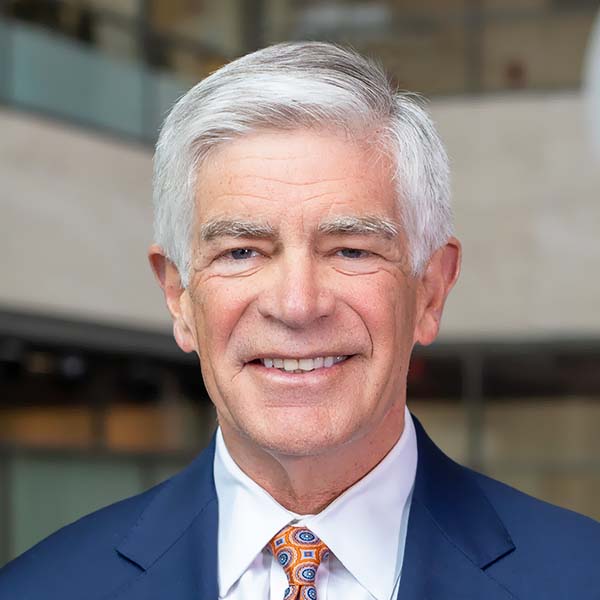Good morning! It’s really great to be back at the University of Delaware for this terrific event. It was wonderful to see so many old friends and to make some new ones at dinner last night. And also, thank you for the lavish breakfast spread this morning. Although since so many of you are health-care workers, I have to admit I was a little self-conscious when I was filling my plate; I hid my two — OK, three — slices of bacon under my fruit, hoping you all wouldn’t notice.
But seriously, thanks so much for having me back in Delaware. It’s always a treat to be on campus because it allows to me to slip back into professor mode. And that’s what I intend to do this morning, though if I recall correctly, the 9:00 a.m. slot was always a little challenging to navigate as a professor. But I’ll do my best to keep you all awake — and if not, well, the coffee station is over there.
I’m going to spend the next few minutes discussing health care as an economic driver. Then, I’ll be happy to take some questions. But before I do, I need to give you what we call the standard Fed disclaimer: The views I express today are my own and do not necessarily reflect those of anyone else on the Federal Open Market Committee (FOMC) or in the Federal Reserve System.
The Changing Economy
I had a chance to walk around the STAR campus yesterday and quite frankly — was amazed at what I saw. Like some of you, I remember when there used to be a Chrysler factory here. I also remember — painfully — when after the 2008 financial crisis, there was a shuttered Chrysler factory here. That was a terrible time.
I was president of UD when the Chrysler plant closed, and I was intimately involved in the university’s decision to purchase the land. But I have to say, what I saw yesterday surpassed even my own optimistic expectations for what would happen to the ground I am standing on. This is now a thriving, mixed-use community where academia, industry, and government are collaborating to perform pathbreaking research focused on clean energy, biotechnology, and, of course, health sciences, among other fields. Instead of Durangos, this area now produces innovations in health care. The “phoenix rising from the ashes” may be an overused metaphor in our culture, but I think it describes best what has happened here.
In a way, I would argue, the STAR campus serves as a metaphor for transitions occurring across our entire country. Traditional manufacturing remains an important component of our economy, but its relative share of employment is declining. This is an extraordinarily painful transition for millions of our fellow Americans and for communities across the country. More must be done to support workers, their families, and their communities as the economy changes.
And change it most certainly has, with the growth of the health-care economy leading the way. In 1960, total national expenditure on health care represented about 5 percent of gross domestic product (GDP). By 1990, that figure was up to 12 percent. Today, about a fifth of our GDP is composed of health-care spending. Health-care outlays are also the federal government’s number one category of spending.
The growth of the health-care sector is evident in employment data as well. In 1990, about 8 million Americans worked in health care; that figure has since doubled to 16 million. That’s the largest single employment segment in our economy.
In other words, the tragic experience of the last two years demonstrated not only how important the health-care sector is to our national fabric, it is extraordinarily important to our economy as well.
A number of factors account for health care’s growing share of national spending. Some are salutary. More Americans have health insurance and thus are able to access — and spend on — care. Life-saving technologies and therapies have been developed. And the country’s population is aging, a reflection, in part, of longer life spans. As people get older, they tend to spend more on health care. That is something I can personally attest to, as I’ve had a number of foot surgeries over the past couple of years as a result of football injuries I suffered decades ago. Moreover, if other products become cheaper, then the national share of health-care spending will, naturally, rise. That is to say, as agriculture became more productive, the relative percent of spending on health care has risen.
But other cost drivers are less desirable. The extremely tight supply of physicians in the United States keeps costs high, for instance. As a Fed president, I stay studiously neutral on political matters, and as a former UD president, I remain neutral on the fact that Delaware is one of only four states without a medical school. But it is a fact that Delaware has relatively few doctors to serve its population, and it is an iron law of economics that when supply is constrained, prices rise. Delaware has a relatively old population, too, which drives demand for health-care services.
Anchor Institutions
With all this said, there can be no doubt that what we call eds and meds — colleges, universities, and nonprofit medical institutions — drive economic activity. These institutions are often referred to as anchor institutions because of the multiple ways they are tied to a place. Unlike corporate headquarters, manufacturing facilities, or sports franchises that can pick up and move — sorry Raiders fans — higher-education institutions and hospitals may sometimes close, but they aren’t going anywhere. As we have seen, health care is labor intensive, making medical institutions some of the largest employers in their regions. And they are generally recession resistant. This part is crucial, too: The research and development functions of higher-education institutions and medical institutions generate new businesses through innovation, technology transfer, and commercialization. In fact, we are seeing that all over the Philadelphia region right now.
OK, now I’m going to break a little bit of news.
In the coming months, the Philadelphia Fed is going to launch what we are calling the Anchor Economy Dashboard. I’m really excited about this. The Anchor Economy Dashboard will be a new, first-ever, national data set that captures the importance of anchor institutions to their regional economies. For the purposes of the dashboard, anchor institutions include higher-education institutions and hospitals. While the dashboard is not live yet, we have the data underlying it, and I’d like to share some with you today.
The State of Delaware has 38 anchor institutions, encompassing both eds and meds. Employment impacts from Delaware eds and meds total 65,316 jobs. That’s the total number of jobs — direct, indirect, and induced — supported by higher education and hospitals in the state.
Direct jobs comprise those employed directly by anchor institutions; indirect are those working in fields that directly support anchor institutions, for example, IT contractors supporting a hospital. And induced jobs are those that are supported by the economic activity that anchor economies generate. The folks working over at Klondike Kate’s have jobs that are induced by UD.
One thing that makes the Anchor Economy Dashboard so neat is that it also calculates a reliance score for each region. The reliance score provides a summary measure of how dependent a regional economy is on anchor institutions. It adjusts economic impact by the size of the regional economy and incorporates measures of impact in terms of employment, income, and gross value added.
For Delaware, our data support what I suspect a lot of us know intuitively: This state is quite reliant on anchor institutions. So, while Delaware’s total employment in eds and meds ranks 46th out of 50 states and the District of Columbia, that is largely a result of the state having a small population. Delaware’s reliance score, we calculate, is 1.23. In other words, Delaware overindexes on eds and meds employment, income and gross value added, compared with other regions. Delaware is 23 percent more dependent on eds and meds for jobs, income, and gross value added than the United States as a whole.
By comparison, Pennsylvania is ranked 15th in reliance at 1.19 and 863,974 total jobs attributable to eds and meds. New Jersey is ranked 25th in reliance at 1.05 and 569,467 total jobs attributable to eds and meds. In other words, New Jersey is almost perfectly average, which pains me as a South Jersey boy to admit. Montana has the highest reliance score at 1.53, with total employment impact from eds and meds at 87,128 anchor institution jobs.
And while I, again, remain neutral on the fact that the State of Delaware does not have a medical school, the data clearly demonstrate how economically impactful having one can be for a region. Take Hershey, Pennsylvania, which has hosted Penn State’s medical school since 1967. The Harrisburg metropolitan statistical area (MSA), which encompasses Hershey, has a total population of 587,291, about half the size of the State of Delaware. But the total employment impact of eds and meds for the Harrisburg MSA is 48,338 — 74 percent of the employment impact in Delaware. Not surprisingly, Harrisburg’s reliance score is 1.45, indicating that the region overindexes on eds and meds jobs, income, and gross value added compared with the rest of the country.
The Anchor Economy Dashboard will be launching on our website — philadelphiafed.org — in the coming months, and if you’re anything like me, you’ll look forward to spending many hours delving into the data.
There is a lot to think about: Regions rich with anchor institutions have benefited from the way these institutions fortify the economy and support community development. But economic dependence on anchor institutions may increasingly come with risks as technology disrupts health care. The pandemic, for instance, accelerated telehealth, creating opportunities for health-care institutions but also loosening the “anchor” that hospitals have traditionally represented. There’s a lot to ponder today — and in the weeks, months, and years ahead.
So, again, thanks so much for having me. Refill that coffee! And now I’m happy to take some questions.
- The views expressed here are the speaker’s own and do not necessarily reflect those of anyone else in the Federal Reserve System.

